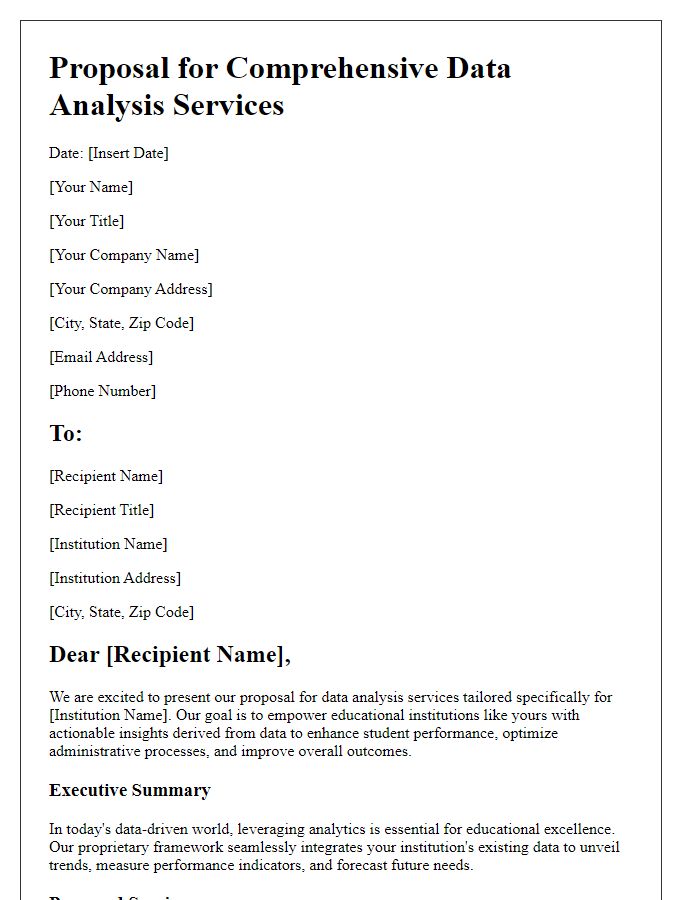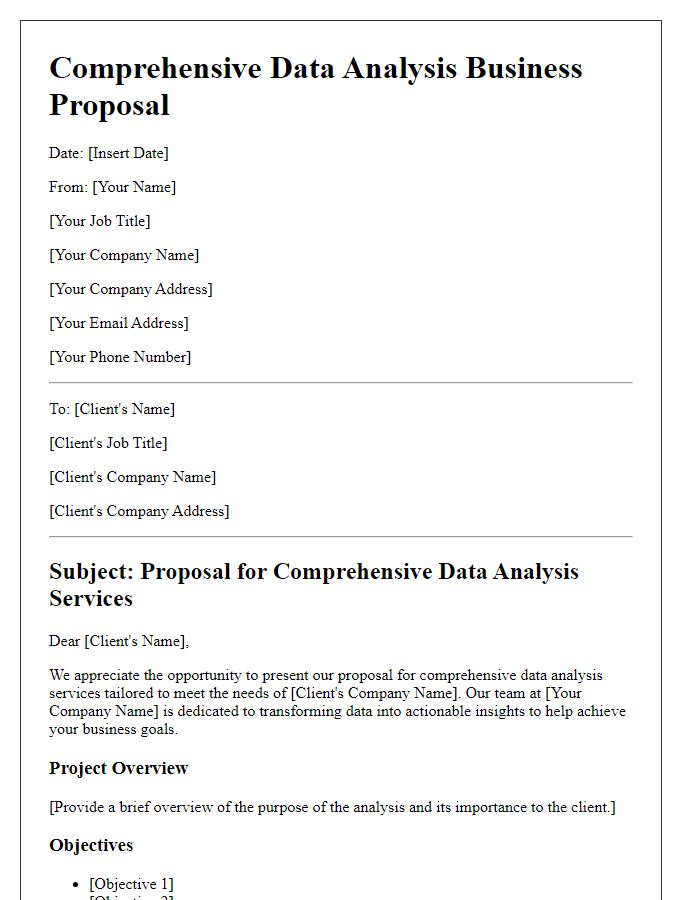Are you looking to take your business to the next level with insightful data analysis? In today's fast-paced world, understanding your data is crucial for making informed decisions and staying ahead of the competition. Our proposal outlines innovative strategies tailored to your specific needs, ensuring your business thrives on actionable insights. Join us on this journey to harness the power of data â keep reading to discover how we can partner for success!

Executive Summary
A well-crafted executive summary is essential for presenting a data analysis business proposal, highlighting critical aspects of the project and its potential impact. This summary typically spans one to two pages, capturing the project scope, objectives, methodologies, and anticipated outcomes. Key areas of focus include the data sources, such as sales figures from 2022 and customer demographics, which will drive insights into market trends within specific industries, for example, e-commerce and retail. Mention the analytical tools, like Python and Tableau, planned for use, which facilitate comprehensive data visualization and insight generation. Additionally, outline the timeline of the project, which is typically structured over a three to six-month duration, emphasizing milestones such as data collection, analysis phases, and final reporting. Finally, underscore the projected benefits, including improved decision-making capabilities and enhanced operational efficiencies for stakeholders, ultimately driving increased revenue and competitiveness in the marketplace.
Objective and Scope
Data analysis plays a crucial role in modern business decision-making, enabling organizations to extract valuable insights from diverse data sets. The main objective of this business proposal is to provide a comprehensive data analysis service aimed at enhancing the operational efficiency and strategic planning of companies across various industries. The scope of this initiative includes data collection (utilizing tools like Google Analytics for web data and SQL databases for structured data), data cleaning (ensuring accuracy of information from sources such as CRM systems), data visualization (using software like Tableau or Power BI to represent findings), and actionable insights reporting tailored to specific business needs. Additionally, the proposal encompasses predictive analytics to forecast market trends and customer behaviors based on historical data patterns, thereby aiding in informed decision-making.
Methodology and Tools
Effective data analysis requires a structured methodology and the right tools to ensure accurate outcomes. Data collection phases, including surveys and database mining, are essential for obtaining reliable datasets. Analytical techniques like regression analysis (for identifying relationships among variables) and clustering (for segmenting data points) play critical roles in interpretation. Tools such as Python (programming language with libraries like Pandas and NumPy for data manipulation) and Tableau (visualization software that simplifies complex data) enable thorough analysis and insight generation. Additionally, machine learning algorithms (such as decision trees and neural networks) provide advanced predictive capabilities for decision-making processes. Implementation of these methodologies combined with cutting-edge tools can drive strategic business decisions.
Expected Outcomes
Expected outcomes of the data analysis business proposal include enhanced decision-making, increased operational efficiency, and improved customer insights. Implementing advanced analytics techniques, such as machine learning algorithms and predictive modeling, can enable organizations to identify patterns and trends within large datasets effectively. For instance, utilizing statistical tools like regression analysis can uncover correlations between customer behavior and sales figures, leading to targeted marketing strategies. Furthermore, leveraging data visualization platforms such as Tableau can present complex information in a digestible format, facilitating deeper understanding among stakeholders. Ultimately, these outcomes aim to drive revenue growth by optimizing resource allocation and enhancing customer satisfaction through personalized experiences.
Budget and Timeline
In a data analysis business proposal, a well-structured budget outlines projected costs, such as personnel expenses, software licenses, and data acquisition fees, which total approximately $15,000 for a comprehensive analysis project. The timeline for the project spans eight weeks, divided into distinct phases including initial data collection (Weeks 1-2), data cleaning and preparation (Weeks 3-4), analysis and modeling (Weeks 5-6), and final reporting and presentation (Weeks 7-8). Regular updates will be communicated at the end of each phase to ensure alignment with stakeholder expectations and timely adjustments if necessary. This strategic approach maximizes resource efficiency while delivering actionable insights.
Letter Template For Data Analysis Business Proposal Samples
Letter template of a concise data analysis business proposal for startup.

Letter template of a detailed data analysis business proposal for corporate clients.

Letter template of a persuasive data analysis business proposal for investors.

Letter template of a professional data analysis business proposal for nonprofit organizations.

Letter template of an engaging data analysis business proposal for educational institutions.

Letter template of a customized data analysis business proposal for healthcare services.

Letter template of a straightforward data analysis business proposal for small businesses.

Letter template of an innovative data analysis business proposal for tech companies.






Comments